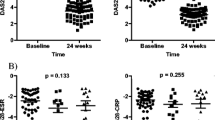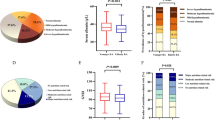Abstract
Objectives
Rheumatoid arthritis (RA) is an autoimmune disease of unknown exact cause, characterized by chronic inflammation. The prognostic nutritional index (PNI), reflecting albumin concentration and lymphocyte count, is a newly established inflammation-based nutritional score. This study aimed to determine the relationship between PNI and disease activity in RA patients.
Patients and methods
This cross-sectional study included 138 RA patients who met the 2010 revised criteria of the American College of Rheumatology (ACR) for RA. PNI was calculated using the following formula: 10 × serum albumin value (g/dL) + 0.005 × total lymphocyte count in the peripheral blood (per mm3). The study population was divided into two groups: DAS28-ESR ≤ 3.2 (group 1 with remission and low disease activity) and DAS28-ESR > 3.2 (group 2 with moderate and high disease activity).
Results
A total of 138 patients with a mean age of 52.1 years were recruited. While the female gender was more prevalent in both groups, it was significantly higher in group 2 (p < 0.05). Group 2 exhibited a lower PNI compared to those in group 1 (42.17 ± 3.46 vs. 44.02 ± 2.92; p = 0.001). Multivariate logistic regression analyses revealed that PNI was an independent predictor of disease activity (OR, 0.850; 95% CI, 0.735–0.983; p = 0.029). ROC curve analysis determined that the optimal cutoff value of PNI for disease activity was 43.01, with a sensitivity of 69.1% and specificity of 57.7% (AUC, 0.66; 95% CI, 0.57–0.75, p = 0.001).
Conclusion
This study demonstrates that the simple and readily available PNI could serve as an independent predictor of disease activity in rheumatoid arthritis patients.
Key Points •The relationship between disease activity and the prognostic nutritional index, which is a nutritional indicator, in rheumatoid arthritis patients was investigated. •It has been shown that there is a connection between low PNI and high disease activity. •It has been shown that PNI can be used to evaluate disease severity with a simple calculation. |


Similar content being viewed by others
References
McInnes IB, Schett G (2011) The pathogenesis of rheumatoid arthritis. N Engl J Med 365(23):2205–2219
Scott DL, Wolfe F, Huizinga TW (2010) Rheumatoid arthritis. Lancet 376(9746):1094–1108
Venetsanopoulou AI, Alamanos Y, Skalkou A et al (2023) The changing incidence of rheumatoid arthritis over time in north-west Greece: data from a referral centre. Scand J Rheumatol 52(4):327–334
Hasegawa H (2018) Assessment of disease activity, structural damage, and function in rheumatoid arthritis. Methods Mol Biol 1868:243–250
Kay J, Morgacheva O, Messing SP et al (2014) Clinical disease activity and acute phase reactant levels are discordant among patients with active rheumatoid arthritis: acute phase reactant levels contribute separately to predicting outcome at one year. Arthritis Res Ther 16(1):R40
van Riel PL, Renskers L (2016) The Disease Activity Score (DAS) and the Disease Activity Score using 28 joint counts (DAS28) in the management of rheumatoid arthritis. Clin Exp Rheumatol 34(5 Suppl 101):S40–S44
Inciarte-Mundo J, Frade-Sosa B, Sanmartí R (2022) From bench to bedside: calprotectin (S100A8/S100A9) as a biomarker in rheumatoid arthritis. Front Immunol 13:1001025
Onodera T, Goseki N, Kosaki G (1984) Prognostic nutritional index in gastrointestinal surgery of malnourished cancer patients. Nihon Geka Gakkai Zasshi 85(9):1001–1005
Seo M, Yamada T, Morita T et al (2018) Prognostic value of systemic immune-inflammation index in patients with chronic heart failure. Eur Heart J 39:70–71
Jeong Y, Jeon SR, Kim HG et al (2021) The role of platelet to lymphocyte ratio and neutrophil to lymphocyte ratio in ulcerative colitis. Intest Res 19(1):62–70
Aletaha D, Neogi T, Silman AJ et al (2010) 2010 Rheumatoid arthritis classification criteria: an American College of Rheumatology/European League Against Rheumatism collaborative initiative. Arthritis Rheum 62(9):2569–2581
Bitik B, Mercan R, Tufan A et al (2015) Differential diagnosis of elevated erythrocyte sedimentation rate and C-reactive protein levels: a rheumatology perspective. Eur J Rheumatol 2(4):131–134
Šućur A, Jajić Z, IkićMatijašević M et al (2020) Combined manual and automated immunophenotypisation identified disease-specific peripheral blood immune subpopulations in rheumatoid arthritis, ankylosing spondylitis and psoriatic arthritis. Clin Exp Rheumatol 38(5):903–916
Ahn SS, Jung SM, Song JJ et al (2019) Prognostic nutritional index is associated with disease severity and relapse in ANCA-associated vasculitis. Int J Rheum Dis 22(5):797–804
Ataş N, Babaoğlu H, Demirel E et al (2020) Use of prognostic nutritional index in the evaluation of disease activity in patients with Behçet’s disease. Eur J Rheumatol 7(3):99–104
Wunder A, Müller-Ladner U, Stelzer EH et al (2003) Albumin-based drug delivery as novel therapeutic approach for rheumatoid arthritis. J Immunol 170(9):4793–4801
Levick JR (1981) Permeability of rheumatoid and normal human synovium to specific plasma proteins. Arthritis Rheum 24(12):1550e60
Wilkinson P, Jeremy R, Brooks FP, Hollander JL (1965) The mechanism of hypo-albuminemia in rheumatoid arthritis. Ann Intern Med 63:109e14
Moshage HJ, Janssen JA, Franssen JH, Hafkenscheid JC, Yap SH (1987) Study of the molecular mechanism of decreased liver synthesis of albumin in inflamma- tion. J Clin Invest 79(6):1635e41
Kaplan H, Cengiz G, Şaş S et al (2023) Is the C-reactive protein-to-albumin ratio the most remarkable simple inflammatory marker showing active disease in patients with axial spondyloarthritis, psoriatic arthritis, and rheumatoid arthritis? Clin Rheumatol 42(11):2959–2969
Zhang H, Yang G, Jiang R et al (2023) Correlation between total bilirubin, total bilirubin/albumin ratio with disease activity in patients with rheumatoid arthritis. Int J Gen Med 16:273–280
Chandrashekara S, Mukhtar Ahmad M, Renuka P et al (2017) Characterization of neutrophil-to-lymphocyte ratio as a measure of inflammation in rheumatoid arthritis. Int J Rheum Dis 20(10):1457–1467
Fu X, Liu H, Huang G et al (2021) The emerging role of neutrophils in autoimmune-associated disorders: effector, predictor, and therapeutic targets. MedComm 2(3):402–413
Targońska-Stępniak B, Zwolak R, Piotrowski M et al (2020) The relationship between hematological markers of systemic inflammation (neutrophil-to-lymphocyte, platelet-to-lymphocyte, lymphocyte-to-monocyte ratios) and ultrasound disease activity parameters in patients with rheumatoid arthritis. J Clin Med 9(9):2760
Ahn SS, Jung SM, Song JJ et al (2018) Prognostic nutritional index is correlated with disease activity in patients with systemic lupus erythematosus. Lupus 27(10):1697–1705
Author information
Authors and Affiliations
Contributions
Nuran Öz: conceptualization, methodology, investigation, data curation, writing—original draft preparation, and visualization. Halise Hande Gezer: conceptualization, methodology, investigation, data curation, and writing—original draft preparation. Selin Cilli Hayıroğlu: conceptualization, methodology, investigation, data curation, and writing—review and editing. Mehmet Tuncay Duruöz: conceptualization, methodology, supervision, writing—review and editing, and project administration.
Corresponding author
Ethics declarations
Disclosures
None.
Additional information
Publisher's Note
Springer Nature remains neutral with regard to jurisdictional claims in published maps and institutional affiliations.
Rights and permissions
Springer Nature or its licensor (e.g. a society or other partner) holds exclusive rights to this article under a publishing agreement with the author(s) or other rightsholder(s); author self-archiving of the accepted manuscript version of this article is solely governed by the terms of such publishing agreement and applicable law.
About this article
Cite this article
Öz, N., Gezer, H.H., Cilli Hayıroğlu, S. et al. Evaluation of the prognostic nutritional index (PNI) as a tool for assessing disease activity in rheumatoid arthritis patients. Clin Rheumatol 43, 1461–1467 (2024). https://doi.org/10.1007/s10067-024-06927-2
Received:
Revised:
Accepted:
Published:
Issue Date:
DOI: https://doi.org/10.1007/s10067-024-06927-2




